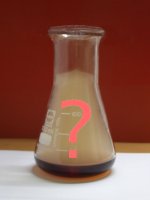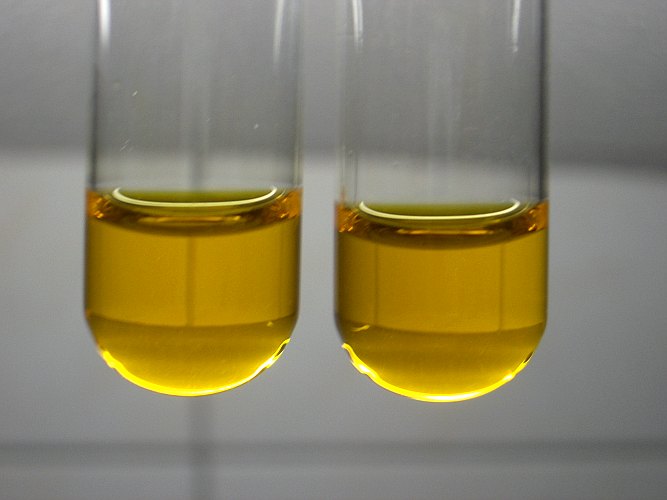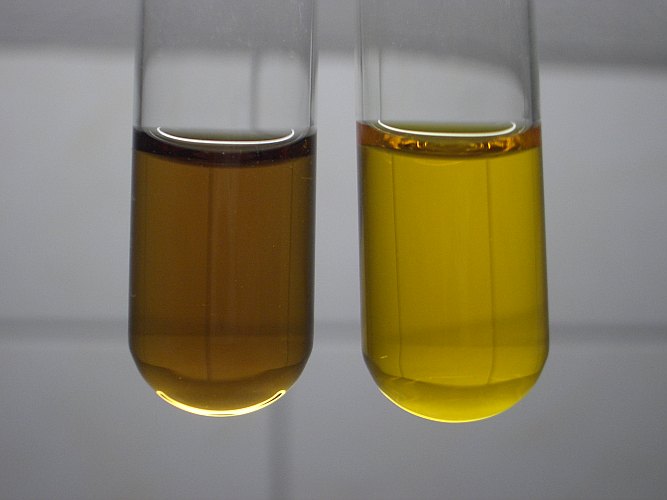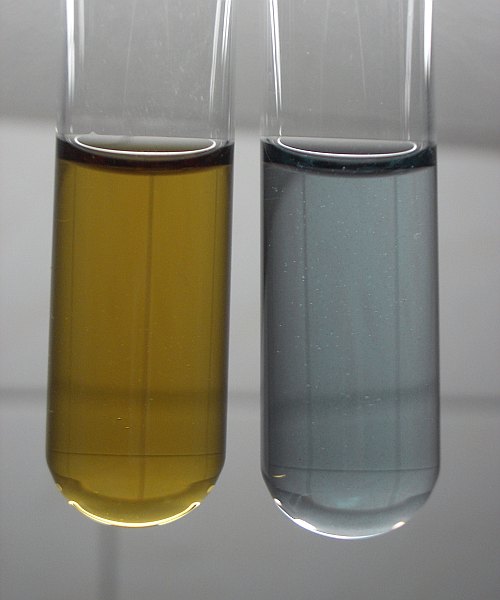


Acid first, or reductor first? Different final results!
In this experiment, dichromate ion is reduced by hydroxylammonium ion, NH3OH+. In this reaction, the hexavalent chromium is reduced to trivalent chromium.
In redox reactions, in which dichromate is involved, in many cases, quite a lot of acid must be added as well. The reaction consumes a lot of acid, which also is shown by the equation of the half-reaction of reduction of dichromate:
Cr2O72– + 14H+ + 6e- → 2Cr3+ + 7H2O
Reduction of dichromates frequently does not occur, or only incompletely, when insufficient acid is present. A nice demonstration of this is the following:
- Add excess sodium sulfite to a solution of a dichromate: the dichromate is only reduced incompletely, a brownish solution is obtained.
- Add excess acid to the sulfite/dichromate mix: the solution turns green at once, all chromium is reduced to the +3 oxidation state.
When the acid is added first, and then the sulfite is added, the resulting solution becomes green at once. The final result does not depend on the order in which the acid and the sulfite are added.
With hydroxylammonium ion, however, this is not true. When hydroxylammonium ion is added first, and then the acid, the final result differs a lot from when an acid is added first, and then the ammonium hydroxyl salt.
Remark: hydroxylammonium sulfate also frequently is named hydroxylamine sulfate. Formally, however, the latter is not correct, the hydroxylamine does not exist as free base, it exists as a protonated ion.
![]()
![]() Required
chemicals:
Required
chemicals:
-
potassium dichromate (sodium dichromate or ammonium dichromate also is suitable)
-
hydroxylammonium sulfate
-
dilute sulphuric acid (dilute nitric acid also can be used)
![]() Required
equipment:
Required
equipment:
-
test tubes
![]() Safety:
Safety:
-
Dichromates are toxic and carcinogens. Avoid exposure to the solutions and the solid.
-
Dilute sulphuric acid is corrosive. If some of this acid is spilled on the skin, rinse it away with lots of water.
![]() Disposal:
Disposal:
-
The solutions contain very small amounts of trivalent chromium and can be flushed down the drain with some water.
![]()
Preparation of the solutions
![]() Prepare a very dilute solution of potassium dichromate in
distilled water, and divide this solution over two test tubes, such that there
is approximately the same amount of solution in both test tubes.
Prepare a very dilute solution of potassium dichromate in
distilled water, and divide this solution over two test tubes, such that there
is approximately the same amount of solution in both test tubes.

![]() Prepare a moderately concentrated solution of
hydroxylammonium sulfate, (NH3OH)2SO4, in distilled
water, and also divide this solution over two test tubes in equal amounts. The
hydroxylammonium sulfate must be in large excess, compared to the dichromate,
so its concentration must be much higher than the concentration of the
dichromate.
Prepare a moderately concentrated solution of
hydroxylammonium sulfate, (NH3OH)2SO4, in distilled
water, and also divide this solution over two test tubes in equal amounts. The
hydroxylammonium sulfate must be in large excess, compared to the dichromate,
so its concentration must be much higher than the concentration of the
dichromate.
![]() Finally, prepare a dilute solution of sulphuric acid (any
concentration between 10% and 20% will do) and also divide this over two test
tubes, each test tube having an equal amount of acid in it.
Finally, prepare a dilute solution of sulphuric acid (any
concentration between 10% and 20% will do) and also divide this over two test
tubes, each test tube having an equal amount of acid in it.
After these steps there are 6 test tubes, each test tube filled with approximately the same volume of liquid.
Adding the solutions in different order
![]() Take one
test tube with dichromate and add the solution of ammonium hydroxyl sulfate to
it. Take the other test tube with dichromate and add the dilute sulphuric acid
to it. The test tube with the hydroxylammonium sulfate added to the dichromate
now is brown, the other test tube still is orange/yellow, it only is more
dilute.
Take one
test tube with dichromate and add the solution of ammonium hydroxyl sulfate to
it. Take the other test tube with dichromate and add the dilute sulphuric acid
to it. The test tube with the hydroxylammonium sulfate added to the dichromate
now is brown, the other test tube still is orange/yellow, it only is more
dilute.

The left test tube contains the reaction products of dichromate with excess hydroxylammonium sulfate, the right test tube contains strongly acidified dichromate. Immediately after adding the hydroxylammonium sulfate to the dichromate, a small amount of colorless gas is produced, this most likely is nitrogen, formed by oxidizing the hydroxylammonium ion.
![]() Finally,
the remaining acid and hydroxylammonium sulfate are added. To the left test
tube with brown liquid, the acid is added, and to the right test tube, the
hydroxylammonium sulfate is added. When this is done, then the liquid in the
left test tube remains brown, the liquid in the right test tube becomes pale
green/grey, and again, a small amount of gas is produced, now in the right test
tube.
Finally,
the remaining acid and hydroxylammonium sulfate are added. To the left test
tube with brown liquid, the acid is added, and to the right test tube, the
hydroxylammonium sulfate is added. When this is done, then the liquid in the
left test tube remains brown, the liquid in the right test tube becomes pale
green/grey, and again, a small amount of gas is produced, now in the right test
tube.

The result of the reactions in the right test tube is what is expected. The strongly acidified dichromate quickly oxidizes the hydroxylammonium and the dichromate is converted to greenish chromium(III).
The result of the reactions in the left test tube, however, is not as what is expected. Apparently, the brown liquid obtained after addition of the hydroxylammonium sulfate already contains chromium(III) only, and the addition of the acid has no effect anymore.
A test with acidified dilute hydrogen peroxide of the brown solution shows that this does not contain free hexavalent chromium anymore. Even trace amounts would be detected with hydrogen peroxide as intensely blue CrO5.
![]()
Discussion of the results
It seems that dichromate is reduced already by hydroxylammonium sulfate, even without addition of extra acid, but it is remarkable that a brown compound is formed, which is very stable. Addition of acid (and even heating to near boiling of the acidified solution) does not result in formation of the well-known green/grey solution of highly dilute chromium(III) in the presence of sulfate.